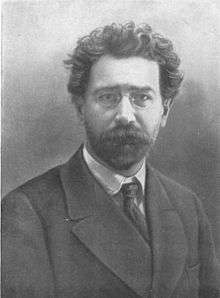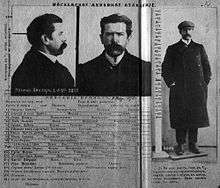Viktor Nogin
| Viktor Nogin | |
|---|---|
 | |
| Chairman of the Central Auditing Commission of the Communist Party | |
|
In office 16 March 1921 – 22 May 1924 | |
| Preceded by | Post established |
| Succeeded by | Dmitry Kursky |
| Personal details | |
| Born |
Viktor Pavlovich Nogin 14 February 1878 Moscow, Russian Empire |
| Died | 22 May 1924 (aged 46) |
| Resting place | Kremlin wall, Red Square, Moscow |
| Nationality | Soviet |
| Political party | Russian Communist Party (bolsheviks) |
Viktor Pavlovich Nogin (Russian: Ви́ктор Па́влович Ноги́н; 14 February 1878 – 22 May 1924) was a prominent Bolshevik in Moscow, holding many high positions in the party and in government, including Chairman of the Moscow Military-Revolutionary Committee and Chairman of the Presidium of the Executive Committee of Moscow Council of Workers' Deputies.
Biography
Viktor Nogin, born in Moscow, Russia to a Family who was the self-educated son of a salesman. In 1898 he joined the Russian Social Democratic Labour Party (RSDLP). He was arrested and exiled several times, spending time in most of Russia's large jails.[1]
Nogin was considered a "conciliator" Bolshevik. In 1910, following the split between the Bolsheviks and the Mensheviks, he convinced the leadership to try to re-unite the party, despite strong opposition from Lenin. This ultimately failed.

By 1917 Nogin was one of the leaders of the Moscow branch of Bolsheviks. He was a member of the Provisional Committee during the struggle against General Lavr Kornilov's failed coup in Petrograd.[1] As Chairman of the Moscow Military-Revolutionary Committee, Nogin tried to lead a peaceful and bloodless transfer of power to the Bolsheviks, hoping to avoid more bloodshed in Moscow.[2] Before a session of the RSDLP Central Committee on 1 November 1917 he joined Kamenev, Zinoviev, Rykov and Milyutin in advocating the creation of a coalition government involving all of the socialist parties, claiming that a Bolshevik-only government could only be sustained through terror. He left government on 4 November 1917.[1]
After he formally admitted his mistakes on 29 November 1917, Nogin was appointed to a national post, where he helped restore the nation's textile industry which had been damaged in the revolution. He enjoyed great authority in foreign trade and industry circles.[1] He accompanied Leonid Krasin to London for the negotiations over the Anglo-Soviet Trade Agreement. In 1923, Nogin traveled to the United States to arrange a major cotton purchase. While there, he helped the Coolidge administration communicate with Moscow using the code of the Russian government, in an attempt to establish friendly relations between the two countries.[3]
Viktor Nogin is buried in the Kremlin wall in Red Square, Moscow.
Positions held
Some of the Bolshevik party and government positions held by Viktor Nogin are listed below:[1]
- Executive Committee of the Moscow Soviet of Workers' Deputies (before 1917)
- Central Committee member at the Sixth Congress of the RSDLP (July – August 1917)
- People's Commissar for Trade and Industry in the first cabinet of the Council of People's Commissars at the Second All-Russia Congress of Soviets
- Chairman of the Moscow Soviet of Workers' Deputies, succeeding Menshevik L.M. Khinchuk, who resigned (5 September 1917)
- Head of Moscow as Chairman of the Presidium of the Executive Committee of the Moscow Soviet of Workers' Deputies (19 September 1917 – 13 November 1917)
- Labor commissar of the Moscow Region and a deputy to the Constituent Assembly (17 November 1917)
- Deputy People's Commissar of Labor of the Russian Soviet Federative Socialist Republic (April 1918)
Legacy
The town of Bogorodsk was renamed Noginsk in his honor in 1930. In 1934, the USSR Post Office produced a 15 Kopeck stamp honoring Viktor Nogin.[4] A station in the Moscow Metro is Kitay-Gorod, originally called Ploshchad Nogina, after a square in central Moscow that once carried the name of Viktor Nogin (now Slavyanskaya Square). Streets named after Nogin still exist in St.Petersburg, Nizhniy Novgorod, Volgograd, Novosibirsk, Pavlovskiy Posad, Samara and Serpukhov.
References
| Political offices | ||
|---|---|---|
| Preceded by Vadim Rudnev |
Mayor of Moscow September–November, 1917 |
Succeeded by Mikhail Pokrovsky |